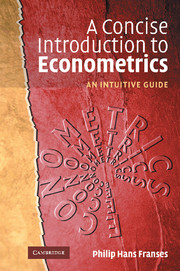5 - Conclusion
Published online by Cambridge University Press: 22 September 2009
Summary
In this book I have aimed to introduce econometrics in a non-condescending way. Chapter 4 contained some case studies which should indicate that the main ideas in chapters 2 and 3 shine through present-day applied econometrics. I decided to choose some of these studies to suggest that there is a straight line from understanding how to handle the basic regression model to handling regime-switching models and a multinomial probit model, for example. The illustrations were also chosen in order to show that seemingly basic and simple questions sometimes need more involved tools of analysis. The same holds for plumbers and doctors who face apparently trivial leaks or diseases, while the remedies can be quite involved. This should not be seen as a problem, it should be seen as a challenge!
Always take an econometrics course!
A natural question that one can ask is whether one needs all these econometric tools to answer typical questions. The answer to this depends entirely on what one wants to do and say. If one is happy with the answer that two countries converge in output because one observes that two lines seem to approximate each other, then that is fine with me. To me it sounds like the plumber who says that there is a leak and then leaves.
Information
- Type
- Chapter
- Information
- A Concise Introduction to EconometricsAn Intuitive Guide, pp. 108 - 110Publisher: Cambridge University PressPrint publication year: 2002
